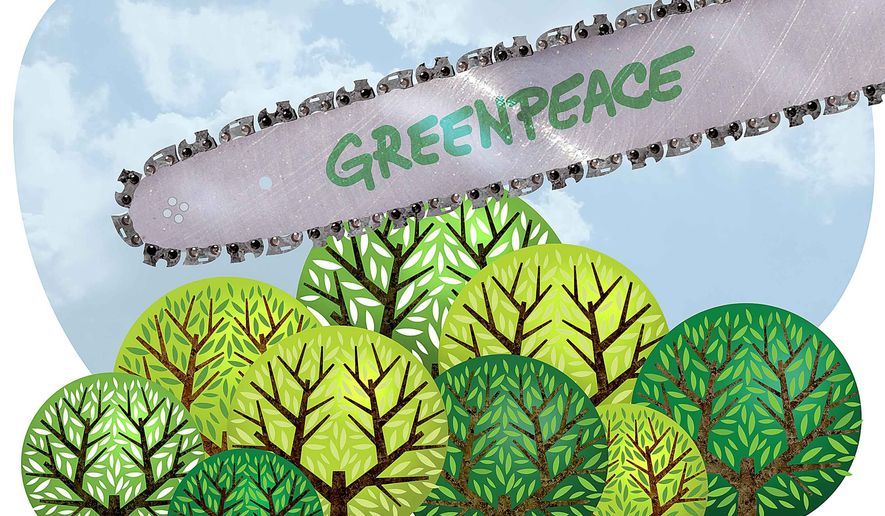OPINION:
Governments and courts around the world are finally cracking down on the eco-terrorist organization Greenpeace. The crackdown, which is long overdue, couldn’t happen to a more misguided bunch of people.
In early December 2014, more than 20 Greenpeace activists damaged a UNESCO World Heritage Site as part of a publicity stunt meant to motivate greater government support for renewable-energy sources they think are necessary to battle supposed human-caused climate change. The activists walked into a “strictly prohibited” area where the Nazca Lines are located in Peru and laid big, yellow cloth letters that read, “Time for change; the future is renewable.”
Because the Nazca Lines are fragile and footprints can last hundreds of years, not even heads of state are allowed to walk there without special authorization, and even then, they are required to wear special shoes. More than 20 people were arrested for the act, but after being bailed out, they skipped the country and as far as I can determine, Greenpeace’s “Nazca Destroyers” have avoided Peruvian justice to this day.
Shortly after that, India’s intelligence bureau declared Greenpeace “a potential threat to national economic security,” calculating the cost of the organization’s activities in India between 2 percent and 3 percent of its gross domestic product each year. Indian officials claim the group has damaged property, engaged in financial fraud, and has falsified data. In early 2015, India restricted the international travel of Indian Greenpeace activists and blocked their access to foreign funding. By September 2015, India had pulled Greenpeace’s license to operate in the country entirely, giving it a month to close down all operations.
More recently, on May 31, 2016, Resolute Forest Products (RFP) sued Greenpeace in the U.S. District Court for the Southern District of Georgia. Resolute claims Greenpeace has violated federal racketeering, trademark and defamation laws.
According to Resolute, Greenpeace’s six-year-old public relations campaign against Resolute — titled “Resolute: Forest Destroyer (RFD)” — falsely accuses the company of destroying endangered forests and species, exploiting aboriginal peoples, and “impairing the [Boreal forest’s] ability to mitigate climate change.”
During the campaign, Greenpeace successfully pressured Home Depot and Best Buy to shift orders or stop purchasing lumber from Resolute. Resolute says Greenpeace’s RFD campaign has cost the company as much as $100 million in lost sales and, as a result, 300 jobs have been cut from operations in Ontario and Quebec.
In March 2013, Canadian courts handed Greenpeace a significant legal setback when it required the group to apologize to Resolute and offer an official “notice of correction” for some of the false statements it made about Resolute’s activities.
In an effort to end the RFD campaign and recoup some of its losses, Resolute sued Greenpeace in 2014 in Canada for defamation and “intentional interference with economic relations.” Greenpeace tried and failed to have the case thrown out, but the Ontario Court of Appeal refused to hear Greenpeace’s appeal of a judgment rejecting its motion to quash Resolute’s claim in January 2015. The Ontario Court of Appeal also ordered Greenpeace to pay Resolute $20,000 in court costs.
Resolute’s is not a “destroyer” of the Boreal forest, as Greenpeace claims. Canada retains about 90 percent of its original forest cover, and agriculture and urbanization — not logging or Resolute’s timber operations — are responsible for the 10 percent of the forest lost in region over the past few hundred years. Less than 0.5 percent of the Canadian Boreal forest is harvested annually. Only a small portion of that is harvested by Resolute.
Every acre Resolute harvests is promptly regenerated naturally, by seeding, or by planting. On average, from 2010 to 2012, Resolute has planted more than 60 million trees per year. The efforts made by Resolute and other companies operating in Canada have resulted in virtually no logging-related permanent loss of Boreal forest acreage. By contrast, Greenpeace has planted no trees in the Canada’s Boreal forest.
Contrary to Greenpeace’s claims, Resolute’s operations have improved, not impaired, the Boreal forest’s uptake of atmospheric carbon dioxide. Numerous studies show — and the United Nation’s Intergovernmental Panel on Climate Change has acknowledged — harvesting in large, older forests provides a significant means of mitigating climate change, because young forest absorb substantially more greenhouse gases than older forests do. In fact, older growth often emits more greenhouse gases than they absorb.
I asked ecologist Patrick Moore, a co-founder of Greenpeace and the former leader of Greenpeace Canada for 15 years, what he thought of Greenpeace’s RFD campaign, only to discover he has been helping Resolute in its battle against Greenpeace.
“I am proud to have worked with Resolute for more than three years on this issue,” said Mr. Moore. “They are the only company in North America to stand up to the lies, blackmail, and extortion tactics employed by Greenpeace.
“Greenpeace has placed fundraising ahead of the truth, and they should be made to pay for the damage they have done,” Mr. Moore said.
I wish more companies had the backbone to stand up to Greenpeace’s extortion tactics. Until they do, when I need forest products, I’ll be purchasing from retailers that buy from Resolute, and I’ll advise my friends to do the same.
• H. Sterling Burnett is a research fellow on energy and the environment at The Heartland Institute.




Please read our comment policy before commenting.